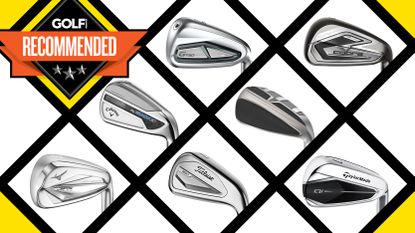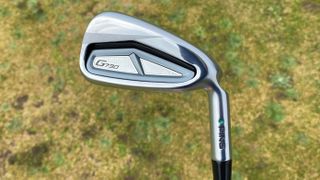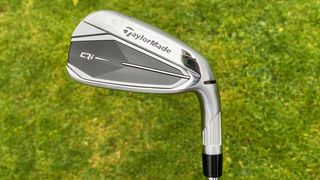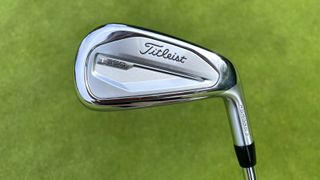Most Forgiving Irons 2024
Looking for a set of irons that will offer forgiveness on off-centre strikes? Here, we take a look at the best sets currently on the market


A well-struck iron shot is one of the great joys of the game. However, the feeling can be a fleeting one, especially if you struggle to find the center of the clubface with any real consistency. Fortunately, help is at hand. Some of the best golf irons available have been designed to be especially forgiving, improving the results of those off-center hits and with it your approach game.
Often referred to as game-improvement irons, these clubs feature specific designs with technology that builds in forgiveness, reducing the problems caused by poor contact and inconsistent swings.
So how do they do this? Typically the most forgiving irons have larger heads with perimeter weighting and plenty of offset. They’ll usually feature a cavity back design too, paired with a wider sole and thicker top edge. They might even borrow elements from the best hybrid clubs, such as hollow construction. Together these elements help get the ball into the air more easily, as well as aiding accuracy and distance, even when the strike is less than solid. The result? Greater confidence and more enjoyment. As such, we have tested lots of different irons and come up with our top picks in the most forgiving irons category below.
If you’re after more yards from your irons then you might also want to consider looking at the best distance irons. Alternatively if you like to shape your approach shots and alter the trajectory, then our guide to the best golf blade irons will be of help. Similarly if you’re beginning to gain confidence in working the ball, the best compact mid-handicap irons are well worth considering.
VIDEO: Joe Ferguson tests and compares the most forgiving irons of 2024
The Quick List

A cleaner aesthetic, significantly improved feel and exceptional distance all add up to genuine progress in the game-improvement category.

The sophisticated look is refreshing and the performance matches. What's more, distance is excellent, but the outstanding forgiveness is the real story here.

A super powerful and forgiving iron that is on the firmer and clickier end of the spectrum in terms of feel and acoustics, but extremely strong in terms of distance.

A very appealing look and a fast but controlled feel, these Mizuno JPX923 irons also offer excellent stopping power.

We found the Wilson Dynapower to be one of the longest irons we've tested. Incredibly fast and forgiving, easy to draw, and excellent value for money.

These Titleist irons are super stable and offer powerful ball speed, whilst still being forgiving. Also have a premium look.
Load the next 3 products

Cobra has produced a high-performing iron, packed with distance and a surprisingly good feel. The dark finish is also aesthetically pleasing and easy on the eye.

Incredibly easy to launch, extremely forgiving and providing a real pop to the strike, the looks of the Halo XL Full-Face won’t be to everyone’s taste but they certainly grew on us.

The Tour Edge Hot Launch C524 irons are an excellent option for players seeking a powerful flight and strong levels of forgiveness. There is plenty of value to be had here.
Most Forgiving Irons
Why you can trust Golf Monthly
Top pick

Specifications
Reasons to buy
Reasons to avoid
The G730 is designed to increase both ball speed and distance. To achieve this Ping has packed the iron with plenty of technology, including its hyper 17-4 stainless steel construction. It also equipped the set with lofts that are between 1.5 - 4 degrees stronger than the brand’s popular G710 irons.
The result is exceptionally high ball speed and a nice penetrating flight, with the former offsetting those stronger lofts somewhat; the launch angle of the 28-degree 7-iron was just over 15 degrees during our testing with a peak height of 95 feet. Vitally, the feel is impressive too. Unlike some of the best game improvement irons designed for higher-handicap golfers, we found the G730s to be neither too hard or too dull. The wider sole has a decent amount of bounce, adding to the club’s forgiveness across a variety of lies.
Unsurprisingly for an iron in this category, the G730s offer sizable blade lengths and a fairly thick top line, both suggesting there’s plenty of assistance at hand. But, once behind the ball, they look far from clunky, instead offering plenty of confidence in a stylish, quality package that’s greatly aided by Ping’s Hydropearl 2.0 finish.
All told, we believe the clean looks, superb distance and surprisingly good feel add up to a truly forgiving iron that’s hard to beat.
- Read our full Ping G730 Iron Review
Best workability

Specifications
Reasons to buy
Reasons to avoid
While workability isn’t perhaps the first thing you’d look for in a forgiving iron, Callaway’s Paradym Ai Smoke irons allow you to do just that thanks to the club’s minimal offset. However, this is accompanied by bags of forgiveness. To achieve this, Callaway says its Ai Smart Face, used across the Callaway Paradym Ai Smoke range, is optimized using swing data from real golfers to increase distance and deliver tight dispersion into the green
Certainly we found that to be the case during our testing; even when we missed the center of the face by as much as 20mm, reductions in ball speed and distance weren’t too penal. Impressively, this is balanced with what we’d best describe as a sophisticated sound and feel.
Callaway has opted for stronger lofts here. So as we expected, they delivered a nice penetrating ball flight, but didn’t generate too much backspin. It’s a trade-off you’ll need to consider, and if you’re looking for more height and greater stopping power on the greens, then irons with higher lofts, like brand’s Smoke Ai HL could be the way to go.
Alongside the club’s superb forgiveness, surprising workability and solid feel comes impressively good looks. They have the refined appearance you typically associate with player’s irons, with the small carbon effect banner strip on the back, that houses the Ai Smoke logo adding to their visual appeal.
- Read our full Callaway Paradym Ai Smoke Iron Review
Competitive distance

Specifications
Reasons to buy
Reasons to avoid
If you liked the look of TaylorMade’s highly-rated Stealth iron - and we did - then you’ll be pleased that, visually, the Qi10s are strongly aligned. There’s a little more chrome and a slightly larger badge, but that’s about it. The longer blade length, generous offset and confidence-inspiring top line all remain.
To provide plenty of forgiveness, TaylorMade uses its patented ‘straight distance’ face technology. It’s individualized to each iron with the aim of eliminating cut spin. Similarly the center of gravity is tailored specifically to each iron - lower in long irons for easier launch and higher in the short irons for better control.
And it works. During our testing we found them to be plenty forgiving, albeit with a slight draw bias, most notable on the longer irons. This is perhaps unsurprising given TaylorMade’s desire to reduce cut spin in these irons - and those who suffer with a slice will no doubt be encouraged.
The Qi10s are seriously long, too. The ball flies off the clubface, with our numbers during testing showing the clubs to be 10 or 15 yards longer than some competitors. Naturally this means lower spin rates and pretty harsh feeling off the clubface, but if you’re needing more distance from your irons, it’s likely a trade-off you’ll be happy to make.
- Read our full TaylorMade Qi Iron Review
Best feel

Specifications
Reasons to buy
Reasons to avoid
The JPX923 Hot Metal irons appear pretty similar to the JPX921 model previously. For us, this is a positive. The refined appearance makes for an appealing looking club. Set behind the ball, the blade size and offset are less pronounced than some of its competitors, making this an option for mid-handicappers, too.
Mizuno has changed the material and sole design though, and with noticeable results. A switch to 4335 Nickel Chromoly means a thinner face, which translates here to more ball speed, higher launch and ball flight despite Mizuno strengthening the lofts compared to the JPX921. Importantly, our dispersion numbers improved too.
Thankfully, we found the changes didn’t negatively impact the feel of the club either. In fact, these are some of the best we’ve tested in the game-improvement category. While it would be a stretch to say it's akin to hitting a forged iron, the quiet sound and soft feel is unlike the harsher experience you can get from some distance-oriented clubs.
We found that the additional bounce in the sole improved turf interaction, adding in little more forgiveness on shots that were a little fat, as well as producing shallower divots all round. It’s also worth noting that for those with slower swing speeds Mizuno also offers a HL option.
- Read our full Mizuno JPX923 Hot Metal Iron Review
Best value

Specifications
Reasons to buy
Reasons to avoid
The Dynapower replaces the D9 in Wilson’s iron line-up, with the brand aiming it at a slightly lower handicap range. That translates to a slightly thinner topline but this is paired with a plenty of offset, a wide sole and a large blade length. To improve forgiveness, Wilson has used A.I. technology to optimize the face architecture of each iron. It also reconfigured the Power Holes 3.0 on the sole, specifically focusing on making the center and toe sections of the club faster as this is where 85 percent of 10+ handicap players strike their shots.
In testing we were impressed with just how fast the irons felt. If distance is your most important consideration then you’ll likely be very happy. To generate these numbers Wilson has equipped the Dynapower irons with some pretty strong lofts - the 7-iron is 27-degrees for example - and this in part adds up to pretty flat ball flight, which makes stopping the ball on the green more challenging. The feel is similar to that of a metalwood, with the ball exploding off the face.
For those seeking distance and forgiveness in a wallet-friendly package the Wilson Dynapower is well worth considering.
- Read our full Wilson Dynapower Iron Review
Best looking

Specifications
Reasons to buy
Reasons to avoid
Titleist are known for making classic looking clubs, even when designing for the higher-handicappers. The T350 is certainly no different. At address it has good blade length and plenty of offset, but the narrower topline and sleek sole give it a refined, almost classic appearance. By covering the cavity with a plate Titleist adds to the aesthetic appeal while also managing the sound at impact. It also makes it a better fit with the best Titleist irons should you want to opt for a mixed set.
In terms of technology, the T350 enjoys the same split tungsten weighting as the T100, T150 and T200 irons. This helps make for plenty of forgiveness on miss hits, with the Max Impact tech and dual taper forger face adding to the great stability that’s the hallmark of this club.
In testing, the club felt fast, with a loud sound and springy feel at impact to match. Importantly for clubs in this category that speed, and launch, was delivered across the face, even on shots hit low on the face. In essence the T350 won’t punish poor swings too harshly and will look and feel good in the process.
- Read our full Titleist T350 Iron Review
Best soft feel

Specifications
Reasons to buy
Reasons to avoid
In a similar vein to Cobra’s Aerojet and King LTDx models, the Darkspeed is another iron that aims to deliver distance and forgiveness. Given the brand’s solid track record in this game-improvement category it’s unsurprising that Darkspeed excels. However, the slight surprise is just how soft these irons felt.
To achieve this blend of attributes, Cobra has opted for progressively hollow heads. The longer irons - 4 through 7 - are completely hollow, while the scoring clubs - 8 through PW - are partially hollow. This allows for the center of gravity to be individualized for each iron.
During our testing this led to plenty of forgiveness, with speed and distance impressive on off-center strikes, while still delivering feedback on the location of the strike. The ball flight is penetrating, which you’d expect from a set of irons with strong lofts like these (the 7-iron is 27 degrees). But it’s that aforementioned feel that really impressed us. By filling the club with a lighter foam material than used in the Aerojet irons, it creates a soft, yet still lively feel that’s a little more blade than game-improvement.
While the charcoal finish is likely subjective, we felt it looked pretty sophisticated. Coupled with the head design - soft curves, thinner topline, reduced offset - it results in an iron that looks as good as it plays.
- Read our full Cobra Darkspeed Iron Review
Easiest to hit

Specifications
Reasons to buy
Reasons to avoid
Certainly the Halo XL won’t appeal to traditionalists. Here is a forgiving, game-improvement iron in all its glory. The iron head is large and the matte-black cavity insert is unlike anything else on the market. There is also plenty of tech here to help with off-center hits, launch angle and distance.
Sole design changes throughout the set; 4 through 7 irons feature Cleveland’s GlideRail soles, designed to improve contact on the harder-to-hit long irons, while the 8 and 9 irons use a v-shaped sole to prevent digging. Finally both the PW and SW use a cambered sole that creates a greater margin of area around the greens and out of the bunkers. You also get full-face grooves, a feature that really adds some confidence at address.
At impact, the feel and sound is lively. It’s more akin to a hybrid than a typical iron but accurately matches, and reflects, the club’s primary purpose. And the distance won’t disappoint - we were genuinely impressed with the carry numbers during our testing.
- Read our full Cleveland Halo XL Full-Face Iron Review
Lively feel

Tour Edge Exotics E723 Iron
Specifications
Reasons to buy
Reasons to avoid
The headliner here is likely the cost but, based on our testing, the performance belies the lower price tag. The irons don’t look ‘budget’ either; we were impressed with the finish and the design. At address the Hot Launch C524 inspires confidence thanks to the generous blade length and ample offset, without looking cumbersome.
Like the best Tour Edge golf clubs, these irons are filled with the brand’s VIBRCOR material, essentially designed to improve both sound and feel. There’s also plenty of toe weighting, designed to add some stability and provide forgiveness.
And we found during our testing it works. The ball leapt off the clubface and there was a real depth to the strike, even on those that didn’t find the center of the clubface. The results were decent ball speed and distance, comparable to more expensive clubs in this category. All-in-all a great value iron.
- Read our full Tour Edge Hot Launch C524 Iron Review
How we test golf irons
Headed up by our deputy editor Joel Tadman, who is then ably assisted by professionals Sam De'Ath and Joe Ferguson, we test golf irons using a comprehensive process that relies on the knowledge and expertise of the Golf Monthly test team. To ensure we’re always up-to-date we regularly attend product launches, where we can learn more about the club’s development and featured technology.
Testing is typically done both indoors, using a simulator with a reputable launch monitor and tour-quality balls, and outdoors. Here we use both the range and the course to test the clubs across a range of playing conditions. It’s through this comprehensive approach that we can really get a feel for the clubs and distinguish the attributes that make them worthy, or not, of recommendation. All our reviews are solely the product of our team’s testing and never the result of payment from a brand.
How to choose irons
When shopping for the most forgiving irons there are a few key factors to consider. Trying out a few different sets is advised, as this will better inform your final decision.
Look and feel
By their very nature forgiving golf irons tend to deliver decent height and distance even on strikes that are well off center. So pay particular attention to any drop off you notice between different sets and then marry this to the attributes you most require, whether that’s increased ball speed and distance, more height, carry or spin.
How the ball feels, sounds and reacts at impact is also important to consider. Better players may be looking for a softer feel, whereas the explosive feel and sound of some forgiving irons is just what’s required to generate distance and provide confidence. Again, there’s no substitute for hitting balls with a few different models so you can compare and contrast both the sound and the feel.
Shape
Often the look and feel of a club is directly correlated to its looks. A typical game-improvement iron that’s designed to be long and forgiving with a higher launch angle will have a larger head with a generous offset and thicker top line. The sole may also have plenty of bounce to improve turf interaction, providing a little more forgiveness on fat shots and generally helping contact across a range of turf conditions.
Forgiving irons also come with a more classic appearance. Think here the Titleist T350 or the Mizuno JPX923 Hot Metal. Here you notice a more compact shape, less offset and thinner top line. You may find that it’s easy to shape the ball with a more traditionally shaped iron such as these.
Price
Price is likely an important consideration. Forgiving irons from premium brands such as TaylorMade, Callaway and Titleist are likely to carry a premium price tag. So if you’re shopping for irons on a budget it’s worth remembering that many of the factors you;re looking for - straighter shots on off-center hits, increased ball speed and distance, etc - can be found in irons that won;t break the bank.
Again it’s vital to try out the irons, comparing the performance, the sound and the feel of lower priced clubs against those that are more expensive. You might be surprised by the results.
Custom Fit
This is probably the most essential part of the iron buying process, no matter the irons you're after or how good you are at the game. A custom fit session will make sure you get the right flex and length of shaft, correct lie angle and correct iron head for your game, meaning you'll finish with a set of irons that will be as suitable as possible for you out on course.
Custom fits can be a daunting process if you're a true beginner or you aren't that confident hitting golf balls in front of people, but they're a vital part of the club buying process. We recommend having a shortlist of three or four iron heads you like the look of before entering a custom fit and then whittling them down to the best for your game during the custom fit process. Custom fits are provided by a number of golf retailers or club professionals at your local golf club.
For more buying advice when it comes to irons, take a look at our brand specific guides such as the best Mizuno irons, best Titleist irons, or best TaylorMade irons.
FAQs
What are the most forgiving irons?
Nearly every brand will offer a forgiving or 'game-improvement' option within its range but irons that stand out as being especially forgiving this year are the Ping G730, Wilson Dynapower, Mizuno JPX923 Hot Metal and the TaylorMade Qi10. When we say forgiveness, we're referring to the consistency of the ball speed when the strike deviates away from the centre of the clubface, as well as the ability to control direction through resistance to twisting, otherwise known as having high MOI (Moment Of Inertia).
What is swing weight
Swing weight in golf is how club makers measure the relative weight of each club in the set so that it feels consistent from one club to the next. It is not a measurement of the actual weight of a golf club, but instead a measurement of the relative weight of the top third of the club to the bottom two thirds.
Swing weight is measured on a scale of A to F bands, with each band graded 0-9. The lightest weight is A0 and the heaviest is F9, but you will find most sets of irons for men will be around D0 and for ladies around C6. Swing weight is measured using a swing weight machine, which looks like a set of scales.
Get the Golf Monthly Newsletter
Subscribe to the Golf Monthly newsletter to stay up to date with all the latest tour news, equipment news, reviews, head-to-heads and buyer’s guides from our team of experienced experts.

Joel has worked in the golf industry for over 14 years covering both instruction and more recently equipment. He now oversees all equipment and video content at Golf Monthly, managing a team of talented and passionate writers and presenters in delivering the most thorough and accurate reviews, buying advice, comparisons and deals to help the reader or viewer find exactly what they are looking for.
One of his career highlights came when covering the 2012 Masters he got to play the sacred Augusta National course on the Monday after the tournament concluded, shooting a respectable 86 with just one par and four birdies. To date, his best ever round of golf is a 5-under 67 back in 2011. He currently plays his golf at Burghley Park Golf Club in Stamford, Lincs, with a handicap index of 2.8.
Joel's current What's In The Bag?
Driver: Titleist TSR3, 9°, Fujikura Ventus Black 6 S shaft.
Fairway wood: Titleist TSR3, 15°
Hybrid: Titleist TSi2, 18°
Irons: Titleist T150, 4-PW
Wedges: Titleist Vokey SM10, 50°, 54° and 58°
Putter: LAB Golf DF3
Ball: 2023 Titleist Pro V1x
- Matt CradockStaff Writer
-
 Which College Players Went Straight To LIV Golf?
Which College Players Went Straight To LIV Golf?LIV Golf has vast experience among its ranks, but a few players made the leap to the big-money circuit straight from college – here are the details
By Mike Hall Published
-
 Tiger Woods Announces Latest Golf Course Design Project
Tiger Woods Announces Latest Golf Course Design ProjectTiger Woods has revealed his latest golf course design project will be called Bluejack Ranch and be based just outside Fort Worth in Texas
By Paul Higham Published